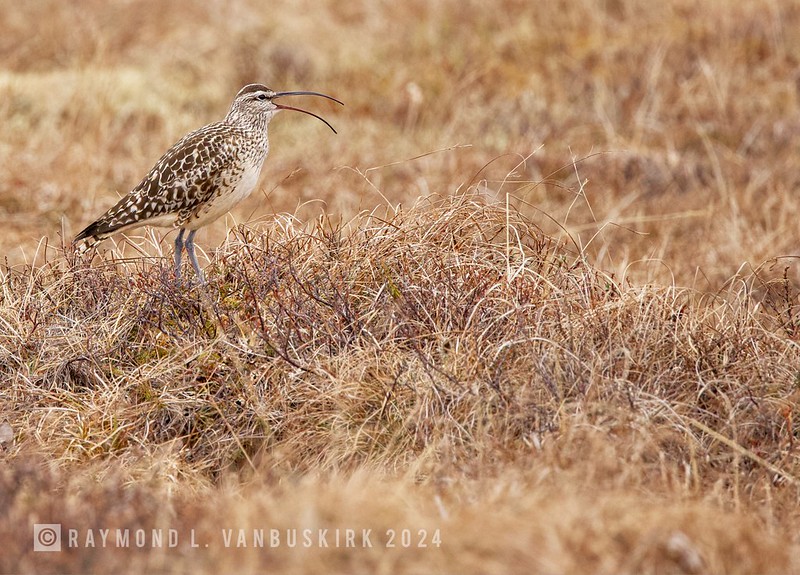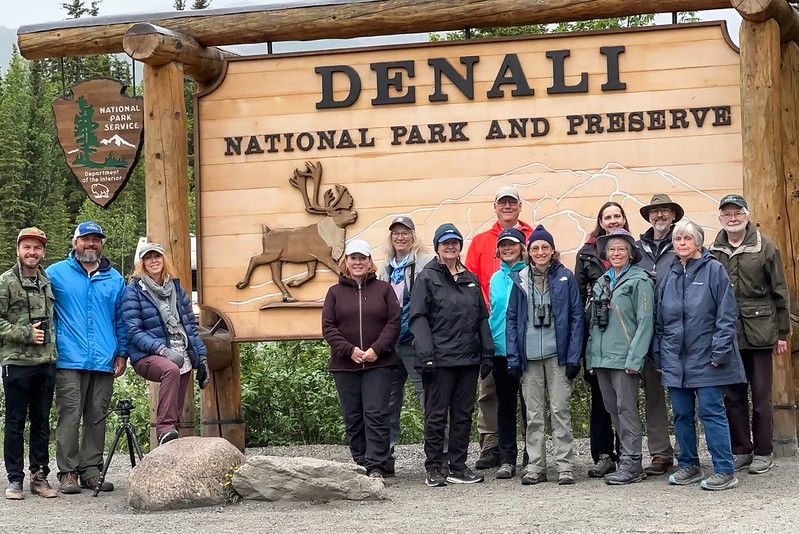Reporting from Alaska: Majesty
We just finished up an amazing trip through mainland Alaska tallying 178 species of birds and a plethora of other flora and fauna. Nome couldn’t have treated us better. The scenery here is unsurpassed and the rarity list is ever growing. Our first afternoon was highlighted by an eye-watering array of shorebirds at the Nome River Mouth, including at least 8 Red-necked Stints at a stone’s throw away.
Red-necked Stint feeding in kelp line (photo Jake Mohlmann)
A late-night chase through the dense fog out to Safety Bridge had us walking along the coastline searching for a very rare species. Eventually a group of Surfbirds revealed a coveted Great Knot feeding amongst them. Nome is perhaps the best place to run into this Asian vagrant in North America.

One of these is not a Surfbird (photo Raymond VanBuskirk)
Raymond spotted a stunning breeding plumaged Curlew Sandpiper at the east end of Safety Sound that took our breath away. Yet another species new for our overall trip list, 1 of 6 write-in shorebird species.

The self-found Curlew Sandpiper takes flight. (Photo Raymond VanBuskirk)
Our normal Nome Dome Roam to search for breeding Bristle-thighed Curlews was abbreviated this year. As soon as we stepped out of the vehicles a male curlew was whistling while displaying right over our heads! We trekked a little way up the trail to get and up close view of this range-restricted breeder.

Bristle-thighed Curlew on territory. (Raymond VanBuskirk)
There was much more snow later in the year so the roadsides were lined with snowbanks. These gave perfect perches for close Willow Ptarmigan, the bird of the trip for some.

We saw over 100 Willow Ptarmigan in one day. (photo Jake Mohlmann)

Our group at Denali. (photo Raymond VanBuskirk)
The Denali portion kicked off with a bang, when we had an extremely close encounter with a male Spruce Grouse. This was certainly an experience we won’t soon forget.

This male Spruce Grouse had no fear. (photo Jake Mohlmann)
We took time to explore the remote tundra along the Old Denali Highway overseen by the endless snow-capped peaks of the Alaska Range. Those that stayed up late got to see an unbelievable sunset over the Maclaren Glacier.

The sun nearly set over the Alaska Range. (photo Raymond VanBuskirk)
The keen eyes of the group found us 2 different Northern Hawk Owls. The second of which had a complete surprise in store. While scoping a perched adult bird, we heard the distinctive calls of some young being emitted from the spruce bog below. We followed the sounds to 3 recently fledged owlets. Another roadside treat was a pair of Bohemian Waxwings that sallied for insects while the group watched in perfect light.

This adorable young Northern Hawk Owl was amazing. (photo Jake Mohlmann)

Watching sleek Bohemian Waxwings never gets old. (photo Raymond VanBuskirk)
We had our own charter boat to explore the scenic fjords, fertile inshore waters and breeding bird cliffs of Kenai Fjords National Park. Having the freedom to pursue whatever we wanted from Orcas to Puffins was priceless. At one point the boat gently floated up to a pair of Kittlitz’s Murrelets, a specialty species of these murky glacial waters.

Our ecstatic group in front of the Aialik Glacier. (photo Raymond VanBuskirk)

A pair of Kittlitz’s Murrelets near shore. (photo Raymond VanBuskirk)
Barrow was full of birds when we got there, including even more Asian vagrant species. A Common Ringed Plover allowed a close study with thick chest band and lack of any eye-ring. We had a completely unexpected Temmink’s Stint show extremely well. Not only did we see it, but we got to observe it in full breeding display mode fluttering around at eye level.

Slam dunk Common Ringed Plover at Salt Lagoon. (photo Jake Mohlmann)

This displaying Temminck’s Stint was fun to watch. (photo Jake Mohlmann)
This is also the place to come and get up close and personal with seabirds on their tundra breeding grounds. We couldn’t have gotten better looks at King, Spectacled and Steller’s Eiders utilizing these small ponds for feeding, resting, and possibly nesting.

A Spectacled Eider pair rest on the shoreline. (photo Jake Mohlmann)

Gorgeous male Steller’s Eider taking flight. (photo Raymond VanBuskirk)
